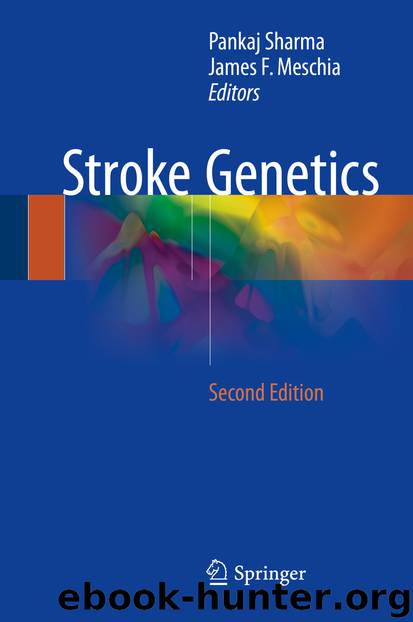Stroke Genetics by Pankaj Sharma & James F. Meschia

Author:Pankaj Sharma & James F. Meschia
Language: eng
Format: epub
Publisher: Springer International Publishing, Cham
Carotid Plaque Burden as a Phenotype
Intuitively, measurements of carotid atherosclerotic plaque have many of the characteristics of an optimal intermediate phenotype for stroke caused by atherosclerotic carotid disease. The connection to the pathogenic pathway is logical, and both plaque burden and progression can be readily imaged noninvasively and quantitatively. Carotid plaque is present in a much larger segment of the population than carotid stroke so it can be readily studied in cohort studies with greater power. However, the clinical relevance of subclinical carotid atherosclerosis remains unclear, particularly when below the threshold for revascularization or when characterized by non-standardized morphological traits such as ulceration.
Initial family based linkage studies found strong evidence for heritability of carotid plaque burden, identifying multiple loci (Chr11p15, Chr14q32, and Chr15q23) with the strongest evidence for variants in the Sex Determining Region Y-Box 6 (SOX6) gene [58]. However, a more recent follow-up study was unable to replicate the association for carotid plaque or other carotid phenotypes [59]. The large-scale GWAS discussed previously for IMT also included carotid plaque volume as a phenotype. The study identified two regions associated with internal carotid plaque volume in both the discovery and the validation cohorts [46]. The SNPs in these two regions, near the phosphoinositide-3-kinase catalytic, gamma polypeptide (PIK3CG) and the endothelin receptor type A (EDNRA) genes, were associated with coronary artery risk in cross-phenotype analyses in the expected direction based on their association with carotid atherosclerosis (Table 12.1). However, similar to the IMT analysis, none of the coronary disease GWAS candidates were associated with carotid plaque burden. Again, no analyses of stroke or other cerebrovascular phenotypes were undertaken in the initial study, and subsequent efforts have failed to show significant association with ischemic stroke or other vascular phenotypes [57] ( Table 12.2).Table 12.1cIMT/plaque associated SNPs reported by the literature and the association results for Second Manifestations of ARTerial disease cohort (SMART). Reproduced from Hemerich et al. [58]
Download
This site does not store any files on its server. We only index and link to content provided by other sites. Please contact the content providers to delete copyright contents if any and email us, we'll remove relevant links or contents immediately.
| Administration & Medicine Economics | Allied Health Professions |
| Basic Sciences | Dentistry |
| History | Medical Informatics |
| Medicine | Nursing |
| Pharmacology | Psychology |
| Research | Veterinary Medicine |
Periodization Training for Sports by Tudor Bompa(8170)
Why We Sleep: Unlocking the Power of Sleep and Dreams by Matthew Walker(6618)
Paper Towns by Green John(5089)
The Immortal Life of Henrietta Lacks by Rebecca Skloot(4525)
The Sports Rules Book by Human Kinetics(4290)
Dynamic Alignment Through Imagery by Eric Franklin(4116)
ACSM's Complete Guide to Fitness & Health by ACSM(3989)
Kaplan MCAT Organic Chemistry Review: Created for MCAT 2015 (Kaplan Test Prep) by Kaplan(3939)
Introduction to Kinesiology by Shirl J. Hoffman(3725)
Livewired by David Eagleman(3683)
The Death of the Heart by Elizabeth Bowen(3551)
The River of Consciousness by Oliver Sacks(3538)
Alchemy and Alchemists by C. J. S. Thompson(3449)
Bad Pharma by Ben Goldacre(3355)
Descartes' Error by Antonio Damasio(3230)
The Emperor of All Maladies: A Biography of Cancer by Siddhartha Mukherjee(3064)
The Gene: An Intimate History by Siddhartha Mukherjee(3047)
The Fate of Rome: Climate, Disease, and the End of an Empire (The Princeton History of the Ancient World) by Kyle Harper(3003)
Kaplan MCAT Behavioral Sciences Review: Created for MCAT 2015 (Kaplan Test Prep) by Kaplan(2936)
